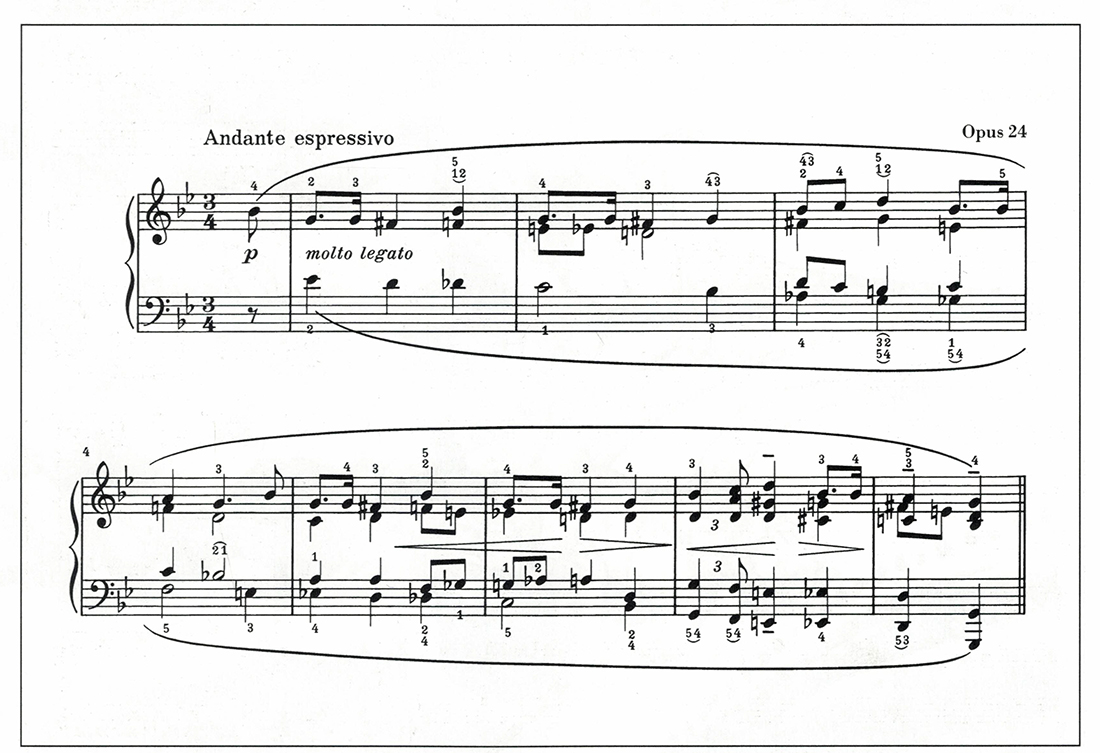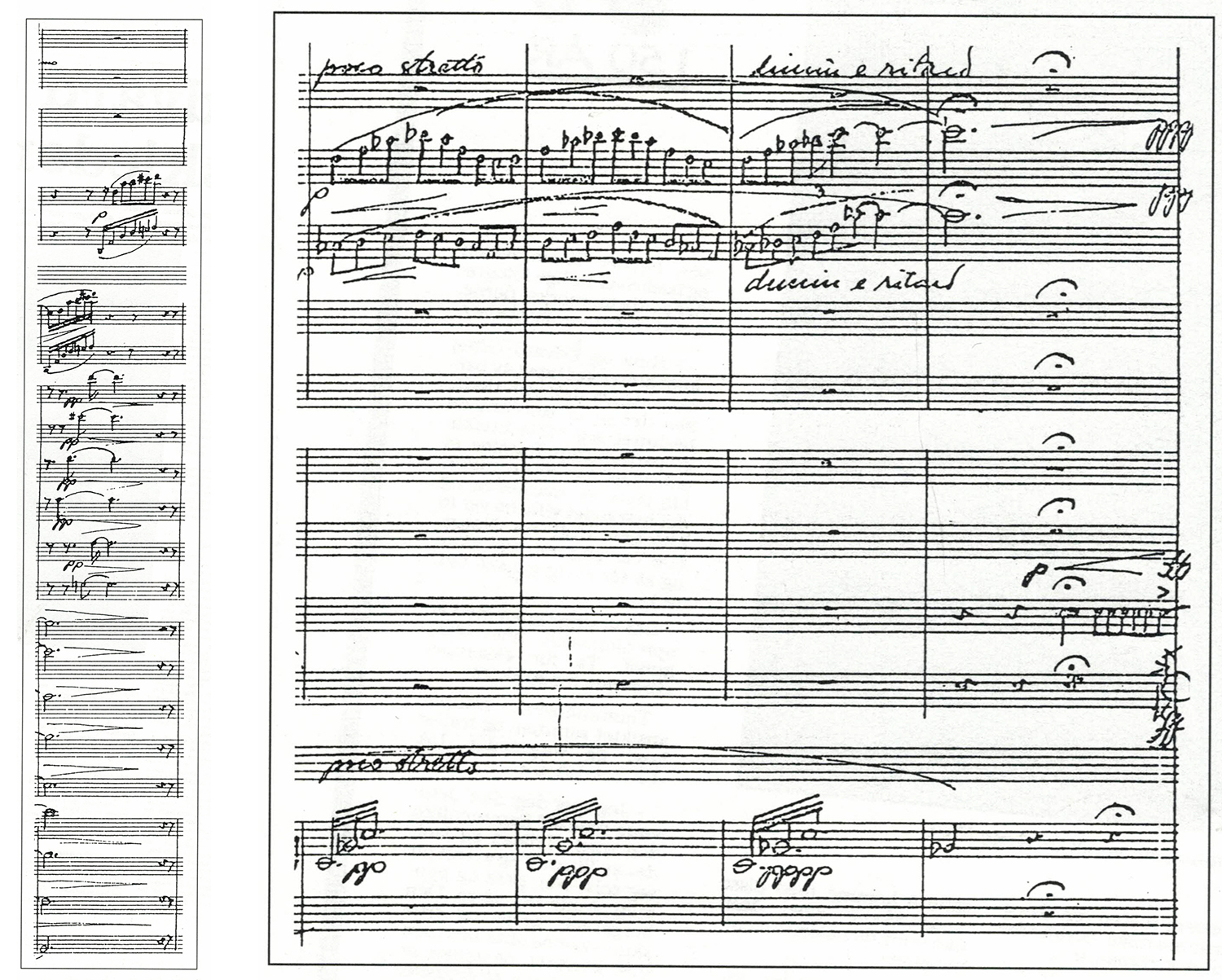The influence of French music on the compositions and orchestrations of Geirr Tveitt
Lecture at Sorbonne University, Paris, Autumn 1993
Several Norwegian composers, such as David Monrad Johansen and Pauline Hall, were influenced in their compositions by aspects of French music which they were able to incorporate into their own specific styles. Whereas Hall was more fascinated by French Neo- classisism, Monrad Johansen showed his «French-ness» in his use of the orchestra, as well as in his love for the diffuse harmonies often attributed to the impressionists.
The remarkable composer Geirt Tveitt (1908-1981) had his formal training in Leipzig and in Paris where he studied with Bigot. All his life, he kept abreast of what was happening in Paris, and many of his works show a distinct elaboration on elements also to be found in French music. In 1935, Tveitt wrote a supremely original ballet entitled Baldurs Draumar (Baldur's Dreams). Unfortunately the score of this work was lost, and we have only a radio broadcast of three movements played by the Oslo Philharmonic played by Carl Garagnly. Students are in the process of attempting to transcribe these pieces so that they may enter the concert repertoire again. In the second movement, called Arrow-Dance, we can hear a striking resemblance to ideas developed by Maurice Ravel in his La Valse a few years earlier. It is well documented that Tveitt and Ravel knew each other, and met during Tveitt's many successful concert tours in Paris where he appeared as pianist.
It has always struck me as highly inappropriate that most conductors continue to emphasize the lushness in the orchestration of Maurice Ravel's La Valse, instead of appreciating the effort that he laid down in creating the crass, ugly, and downright hysterical sounds we find in this piece. La Valse is Ravel's attempt to imitate the expressionistic instrumentation developed by the likes of Alban Berg in Austria. The basic material of La Valse consists of a waltz-cliché of dubious quality. But it is not the waltz itself that Ravel is interested in. It is continually surrounded and distorted by grotesque structures that ultimately «tear it up» right in front of our ears.
In the final passage of the Arrow-Dance, we find a similar «tearing up» of a basically banal musical idea. The arrows are depicted as brilliant showers of sound that ultimately gain a sonic life of their own.
It is also possible to ascertain an influence of Ravel's Une barque sur l'ocean from 1909 on the movement entitled Celebrations round the Bridal Boat from the fourth suite of Geir Tveitt's A Hundred Folk Tunes from Hardanger (1958). The Ravel composition is a gorgeous evocation of limpid water-inspired colortistic music which consists of a kernel of melodic/harmonic material which is surrounded by more amorphous instrumentation. This illustrates a boat floating on the water perfectly. Here, the instrumentation consists of delicately blended instrumental colours, and the resulting waves of sound erase all feeling for individual instruments.
Geirr Tveitt is attempting much the same tone-painting in his boat scene, but here the surrounding material is much more diffuse as befits a composition written much later. We are reminded of French composers like Florent Schmitt, Charles Koechlin, and even Olivier Messiaen who already had written similar textures in his Turangalîla Symphony more than a decade earlier. Tveitt's composition confirms his continuing desire to reflect contemporary developments in France into his work.

Fig 1 – From the fourth suite of Geirr Tveitt: A Hundred Folk Tunes from Hardanger. With the permission of the Tveitt family.
On Geirr Tveitt's orchestration of Grieg's Ballade
Norwegian musicologists are very fond of underlining the connections between Grieg's harmonic experiments and relate these to the development of the harmonic language we associate with French Impressionism in music. While these connections obviously exist, it is meaningless to ignore the common root of this new language which is obviously to be found in the hamonic language developed by Richard Wagner. Both Grieg and numerous French composers of note were in Bayreuth for the great festival in 1876. The effect of this experience cannot be sufficiently emphasized, and subsequent developments in these composers' harmonic language must be seen as an individual response to what they experienced there.
Edvard Grieg's musical education under Reinecke in Leipzig emphasized a thorough grounding in German formal thinking. It is my contention that Grieg's natural harmonic talent would have been far more stimulated had he studied in Paris with the successors to Antonin Reicha teaching at the Paris Conservatoire. Grieg's formal sense is frankly unadventurous and conventional. It is precisely in his harmonizations of traditional Norwegian tunes that his striking originality as a composer becomes apparent. This is particularly evident in his major work for piano solo: The Ballade in G minor written in 1875/6.
Geirr Tveitt wrote the following about Grieg's Ballade in a letter to the Norwegian composer Sverre Bergh, dated the 15th of December 1976: « ... I have always held the opinion the Ballade is really an orchestral composition. I do not exaggerate when I say that I have played it at least 100 times in concerts, hut never in Norway. I have even recorded it for the French record label Paris-Intel. The conductor Harald Heide studied my transcription and was enthusiastic (excuse my self-promotion), but I did nothing about having it performed. Rather the opposite. A definite weakness in the original composition is that the early variations are altogether too often in the same key (G minor), and as an addition I had decided to transpose a few of them into another related key. Maybe I was being a bit impertinent but I really believe it helps the composition as a whole.» It is not definitively certain as to when this orchestral transcription was made, but indications point to the years 1944-54.
When the archive of the Norwegian Society of Composers was transferred to the Norwegian Music Information Centre, an unsigned copy of the orchestral Ballade emerged. The question arose, who had made this transcription? The composer Øistein Sommerfeldt read through the composition and it was obvious that it was a very professional piece of work. He suggested that the score be delivered to the Norwegian Music Collection at the National Library where they would be able to ascertain the arranger. This happened in 1979 /80, before the Music Information Centre had started collecting all Geirr Tveitt's manuscripts, so there was no-one there who could recognize the calligraphy. When the librarian Øyvind Norheim was going through some of Geirr Tveitt's letters, he came across the above mentioned letter to Sverre Bergh where he proclaims that the arrangement of Grieg's to be lost. He remembered the copy he had delivered to Sommerfeldt, found the manuscript and identified the handwriting. When Norheim subsequently showed the score to Mrs. Tveitt, there could be no doubt as to the arranger.
We know that Grieg connected the key of G minor with compositions of a highly personal nature (the string quartet). Grieg wrote the Ballade in the aftermath of the turbulence surrounding his parents' death. The choice of theme, although a folk melody, is not the best of materials on which to construct a set of variations. The theme itself is remarkably phlegmatic, and the melodic contour keeps closing in on itself, which decreases its effectiveness as a suitable subject for variational treatment. Grieg compensates for this by draping the melody in a rich sequence of falling chromatic chords which itself is a much more promising basis for variational development. The eminent Norwegian musicologist Harald Herresthal has made the point that Grieg's harmonic boldness can also be attributed to his attempting to imitate the microtonality inherent in much Norwegian folk music. The chords colour the melody and by implication serve to imitate tones that are in just intonation.

Fig. 2 – The theme of Grieg's Ballade.
The first variation resembles the similar passage in Brahms' Haydn Variations in that the theme itself is virtually erased, and the chordal basis functions as the main framework. Grieg begins his sec of variations furthest away from the theme itself.
The second variation continues the harmonic development, but this time the end of the phrase is replaced by an upward dissolving arpeggio which introduces elements of pure sound and abstract sound-gesture. This figure itself becomes an integral element itself generating objects for variation. Geirr Tveitt instrumentates this idea with extreme delicacy introducing a waft of celesta sound to accentuate the dissolve (Fig. 3).
Geirr Tveitt made this transcription as a study in instrumentation. He does not try to imitate the piano sound of the original, hut rather uses Grieg's material as a basis for a new independent orchestral composition. The swirling passage mentioned above is rendered with Ravelian elegance using the celesta to crown the sonic gesture.
The ninth variation is the freest of the set and functions as a kind of cadenza in the overall composition. The piece resembles in many ways the Nocturne from the set of Lyric Pieces, Op. 54. That piece written in 1891 consolidates the floating harmonies that he created in this composition written nearly twenty years earlier. The harmonic ambiguity is extreme, and the beautiful free passage toward the end fairly lets the listener float into a world later inhabited by the likes of Debussy. It is precisely such passages which reenforce arguments to support the contention that Grieg indeed influenced the development of the French harmonic language.
Geirr Tveitt here unfolds his love and understanding of the art of instrumentation as developed in France. The second part of the variation is given a different orchestral colouring that the first, and it is especially effective the second time around, where the clarinets are accompanied a delicate trill on the celesta. The influence of France is everywhere.

Fig. 3 – Geirr Tveitts arrangement of Ballade - Variation 2.
Fig 4 – Geirr Tveitts arrangement of Ballade - Variation 9.
With the permission of the Tveitt family.
Published in the homage volume Olav Anton Thommessen – Inspirator – Tradisjonsbærer – Rabulist, Norsk Musikforlag c. 1996.
With permission